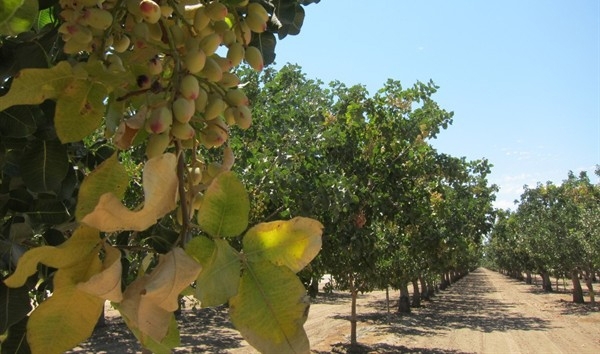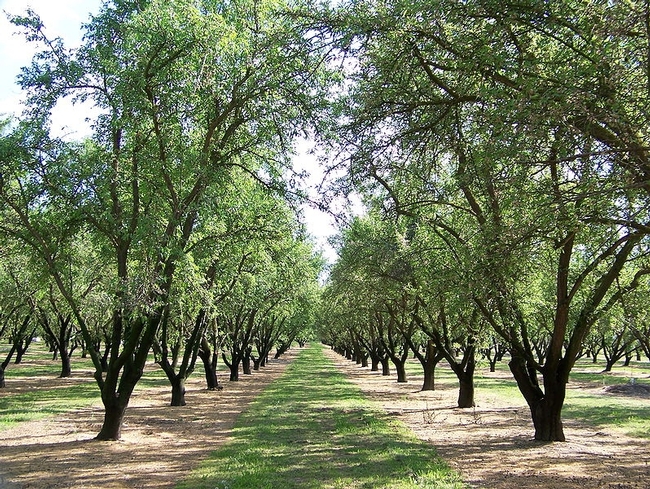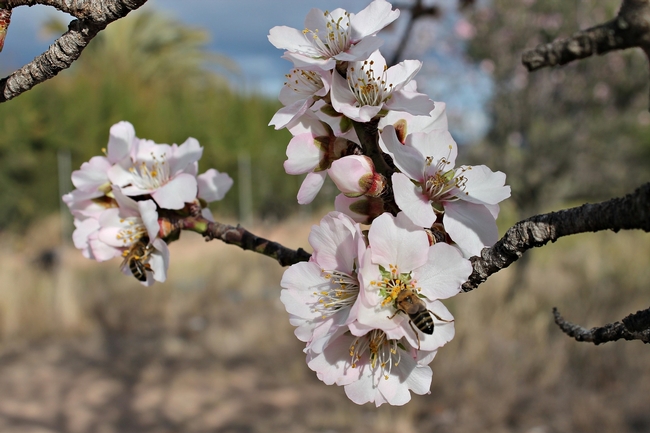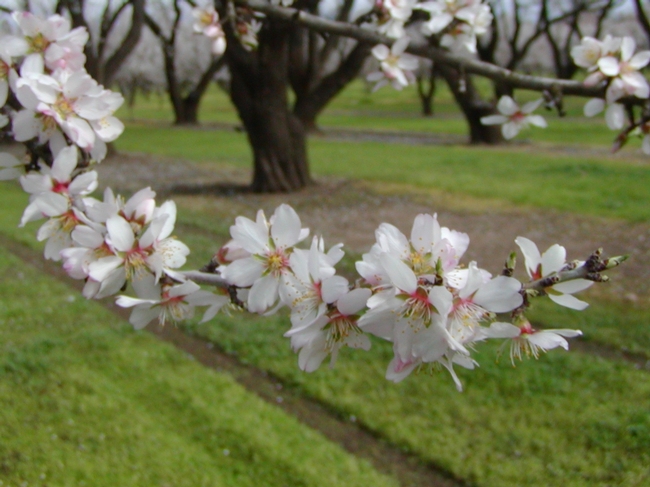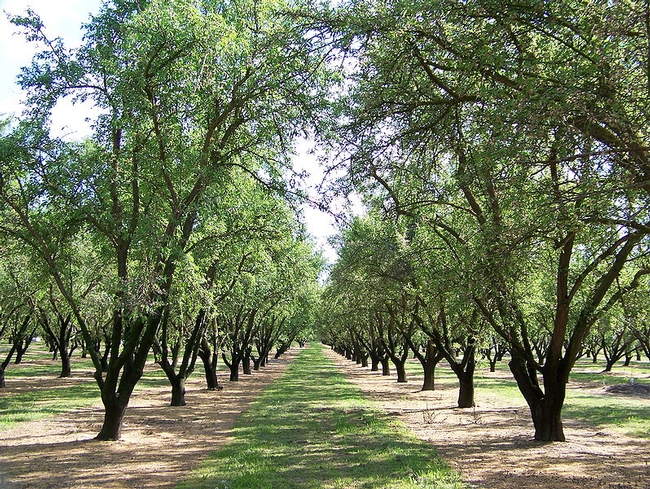Posts Tagged: almonds
Climate and California agriculture of the future
One of the forces driving agricultural experiments in California's fertile San Joaquin Valley is climate change, reported Mark Schapiro on Grist.org. Although some sources still don't feel completely comfortable with the concept.
"Whether it's carbon built up in the atmosphere or just friggin' bad luck, the conditions are straining us," said John Duarte, president of Duarte Nursery.
The state's fruit and nut orchards are taking the most heat as conditions change. A fruit or nut tree planted today may be ill-suited to climatic conditions by the time it begins bearing fruit in 5 or 10 years. Between 1950 and 2009, “chill” hours trees needed annually to reboot trees' metabolic system for the spring bloom had already declined by as much as 30 percent, according to a California Department of Food and Agriculture study.
“If trees haven't had that low-chill period when they wake up in the spring, it's like being up all night and then trying to go to work.” said Mae Culumber, a nut crop advisor with UC Cooperative Extension in Fresno County.
Researchers have already observed that cherry, apricot, pear, apple, pecan and almond trees are often less productive than they used to be.
The article said farmers may turn to pistachio trees to weather a warmer and dryer California. Pistachio trees require one-third to one-half as much water as almond trees. During droughts, pistachio tree metabolism slows and when water returns, they start producing nuts again. And they can produce nuts for 80 years or longer, almost four times the life span of an average almond tree.
For field crops, scientists are looking at improving the soil and transforming growing systems to help farmers adapt to the warming climate.
“When I drive to the Central Valley, I get goosebumps; I feel the urgency,” UC Davis agronomist Amélie Gaudin said. “I see an agriculture that is basically hydroponics. It's like a person being fed/kept alive by an IV.”
“What happens when you no longer have the sugar-water?” she adds.
Gaudin is focusing on using agroecological principles to develop efficient and resilient cropping systems. Planting cover crops and reducing tillage show promise for mitigating the impact of climate change in the valley.
Internet start-up gleans trust from association with UCCE
Ceres Imaging, an Oakland-based start-up, is working closely with UC Cooperative Extension on its aerial imaging of farm fields, a fact that is helping the company gain trust by association, reported Emma Foehringer Merchant on Grist.org.
Ceres puts equipment on low-flying airplanes to take pictures that will help farmers optimize water and fertilizer application. According to field tests, the imagery works. Since 2014, Ceres has teamed up with UC Cooperative Extension to conduct field trials, including one for the Almond Board that measured the response of nuts to different rates of watering.
In that study, data from Ceres' imaging matched well with the UCCE ground "truthing," said Blake Sanden, UC Cooperative Extension water and soils farm advisor.
According to the article, "Ceres' relationship with the extension program has helped the company gain trust with sometimes-skeptical farmers." Sanden called UCCE trials the "gold standard of efficacy" for new products in the ag market.
There is also increased interest in precise water management after years of drought and cutbacks on federal water allocation.
"The attitude (among farmers) used to be, 'I can find water,'" Sanden said. "I would say that 30, 40 years ago, there was an attitude of hope ... that some of the restrictions on pumping water (would) go away." He said growers expected decision-makers "to come back to reality and understand that we've got to make money in California and grow food."
But the restrictions didn't go away. Instead, they became stricter. The uncertainty about water deliveries has made farmers friendlier to new technologies, like the one offered by Ceres.
The 2017 tree nut and fruit season begins with a mixed bag
Wet and wacky winter weather may wreak havoc on the almond crop, but UC Cooperative Extension advisor Franz Niederholzer has promising words for farmers concerned about adequate pollination, reported Heather Hacking in the Chico Enterprise-Record.
“You don't need them to all be pollinated,” he said. A pollination rate of 40 percent would make a great year. Twenty five percent will still produce a decent crop.
The heavy rain, wind and cold temperatures that have characterized January and February 2017 could be overcome with just a bit of warm, sunny weather. In Chico, the weekend of Feb. 11-12 were sunny, as was Saturday the 18th. Those were good days for bees to fly.
Fungus is also a concern, said Danielle Lightle, UCCE advisor in Glenn County. Typically farmers watch the weather and spray fungicides before it rains. However, the persistent rain made orchard floors muddy, unfavorable conditions for moving heavy spray rigs.
Farmers who have been in the business for a while know that the golden rule is to “control what you can and let go of what you can't,” Lightle said.
Almond prices dip as global demand plunges
Despite the state's four-year drought, almond production continued its steady rise over the last 15 years. The plunge in global demand may impact the trend, according to UC Agriculture and Natural Resources Cooperative Extension advisor David Doll. Last year Philpott asked Doll how long the almond boom would continue.
"He told me it would only stop 'when the crop stops making money,'" Philpott wrote.
Doll explained that, under normal water supply conditions, the break-even farmer price for almonds is $1.45 per pound. But when water is scarce and farmers pay more for water, the break-even price rises to $2.60 to $2.85 per pound. The Fresno Bee this month reported that almond prices dropped about 20 percent to $2.50 to $2.75 per pound.
Growers are hoping that El Niño will reduce water costs and that the Asian and European appetite for almonds returns to normal, pushing up the almonds' value once again.
Ezra David Romero of Valley Public Radio reported that the strength of the U.S. dollar also reduced buyer interest in California almonds.
"We probably pushed the price up too high," said Darren Rigg of Meridian Growers in Tulare, Calif. "It killed off demand, and people at a certain point, they just don't buy."
In the web version of Romero's story, he used a picture of UC ANR's David Doll in an almond orchard.
Norwegian newspaper covers California's drought
The California drought is so severe, it is drawing worldwide attention, including recent news coverage in Norway. Reporter Kristoffer Rønneberg visited a farm and reservoir in the Central Valley and spoke to a UC Agriculture and Natural Resources expert for an article in Aftenposten (Evening Post), Norway's largest newspaper.
"Look at this," said west side farmer John Diener. "In this field, I tried to cultivate a type of wheat that doesn't need as much water. But it did not (thrive). We did not get enough rain. Now the entire crop has withered." (Translation by Google Translate.)
Rønneberg walked on the bank of Millerton Lake, north of Fresno, where he would have been wading through water in a normal year. He reported that the reservoir is at 30 percent of its capacity.
The reporter also touched on a common theme during the 2010-14 drought: the water needs of California's almond crop, which has more than doubled in size over the last 20 years. Each almond, the story said, requires 4.2 liters of water.
"There are many who believe that almonds require much more water than other plants. That's just nonsense," Diener said. "But there are some who have an interest in blaming farmers for water shortages, and they have chosen to use the almond as a kind of symbol."
The Norwegian newspaper reported that urban Californians were irritated when Gov. Brown's April 1 water conservation restrictions didn't include agriculture.
“Why should they give up their lawns when farmers are growing vegetables, grains and nuts?” the story asks, noting that a significant portion of alfalfa and almonds grown in California are exported to other countries.
Doug Parker, director of the UC ANR California Institute for Water Resources, said that's the wrong way to look at the issue. “So what if it is exported?” Parker said. “We also import plenty of food to California. That's how the global market works.”

